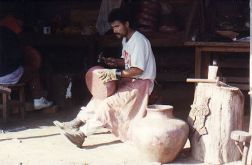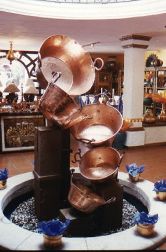December 1996
Mexico
<<<
Sunday, 1 December 1996
Cleaning and servicing the car and RV continued to be the
name of the game. The leak on the ice maker was traced to two loose screws which
when tightened appeared to of cured the problem. We attended the first happy
hour of the rally which apparently will be a daily event throughout the tour, as
will be the optional Spanish lessons. Today it was more of an opportunity to
meet our fellow travellers, it does appear that we are amongst the younger
generation! We were very pleased to hear that several couples are going for a
second time as they enjoyed their first tour.
Monday, 2 December 1996
Nineteen rigs out of twenty have now arrived, most spending
the day cleaning, servicing and obtaining Mexican insurance, pesos and the like.
Today's happy hour was a briefing session for the trip, and travel logs and
forms for the border crossing were issued. It seems that the Mexicans love
paperwork as we have to fill out numerous forms as well as show rig ownership
titles, passports, credit cards, and driving licenses and provide photocopies of
everything.
Tuesday, 3 December 1996
We heard about the Aztec tour from a couple (Fred and Jann)
at the FMCA rally in Billings, Montana. Well to our surprise they arrived
today and will stop at the campground for a couple of days. They are planning an
RV tour of Europe in May 1997 so they invited us out to lunch so they could quiz
us on travelling in Germany, France and the UK.
Wednesday, 4 December 1996
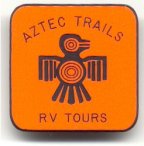 |
|
The caravan departed promptly at 7 am heading for
the Mexican border crossing over the Rio Grande
to Ciudad Azeman some forty miles
from Mission. As forecast by the wagon master, it took over two hours
for the caravan to complete the border crossing formalities, which
included a humourous passport inspection as an official studied
Valerie's passport with a magnifying glass!
|
After this, each motor vehicle owner had to present a
mountain of paper to obtain a windscreen sticker which gave clearance for the
vehicle to enter the country. This was followed by an inspection of all rigs by
armed guards who were looking for guns, drugs and any imported items that we may
try to sell, like computers or TV. The first forty kilometres into Mexico is a
free trade area after which we went through another checkpoint where the guards
verified that the vehicle VIN number tallied with the paperwork.
The scenery for the first 150 km (yes Mexico is metric) is
very similar to that in Texas, being mainly flat scrubland. Even though the
weather was overcast and wet, a lot of smiling people waved as the caravan
passed by. As it turned out all the rig cleaning that had taken place during the
past few days was a complete waste of time, since the combined drizzle and muddy
roads meant that by the time we arrived at the overnight stop, every rig was
unbelievably dirty. To avoid some of the busier town centres we took several
private toll roads which were almost empty, which was not surprising as the cost
on one twenty km stretch of the toll road was about £18.00!
After 200 km we climbed a mountain range but because of low
clouds, we missed what were probably some superb views. We boondocked for the
night in the Convention Centre car park in the town of
Saltillo, where we had our first Spanish lesson, driver’s briefing
meeting and an enjoyable Tex/Mex chilli cooked by Ann, the wagon master’s wife.
Thursday, 5 December 1996
Today the caravan was split into three groups and we found
ourselves in the last group which departed at 9 am for the 150-mile journey to
Matehuala. Even though we were on trunk roads the
road surface for the most part was poor, requiring concentration to avoid
potholes or a steep drop-off at the roadside. Traffic was almost exclusively a
constant stream of 18-wheel trucks overtaking precariously. It was very
noticeable that there were relatively few cars. At a toll, we were pulled over
by armed guards who wanted to inspect the RV. We formed the impression that they
had seen so few big American RVs that they were just being curious. The first
job for many when we arrived at the Las Palmas campground was to attempt to wash
some of the mud from the cars. Happy hour was a Spanish lesson followed by
delicious Mexican hors d'oeuvres accompanied by several Margaritas.
Friday, 6 December 1996

|
|
In a convoy of nine cars, we travelled along quiet
roads to the remote village of Real De
Catorce, which is located in the mountains at about 9,000 feet.
The village was the second richest source of silver and precious metals
in Mexico from the late 1700s until 1940. In its day it was a very rich
area with a population of 40,000, but today even though some 1,200
people still live there much of the village is in ruins. The drive up is
a rough ride, the last 15 miles are cobblestone and the final two miles
are through a former railroad tunnel right through the mountain - single
lane, one way at a time.
|
|
A big church in the centre has a floor made of
coffin lids and a figure of "Panchito" (St. Francis) that is believed to
be miraculous. Thousands of "Retablos" on tin cover entire walls,
describing the most incredible cures and last-minute rescues from
disaster. Each Sunday pilgrims come by bus load, but as the big busses
cannot pass through the tunnel, pickup trucks do a lively trade carrying
about 15 pilgrims each through the tunnel.
|
|
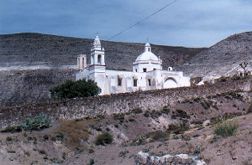 |
We watched silver jewellery being hand produced in very
primitive conditions and along the village, street children came
up to beg or sell coloured stones for pesos. Even though the
living conditions are very primitive and more like what you would
expect a few hundred years ago, everybody in the village was very
friendly and gave us a smile or a wave as we passed.
Saturday, 7 December 1996
The 110-mile drive to the La Mesquite motel and trailer
park in San Luis Potosi is along a fairly
flat plateau which is mainly covered in a variety of cacti, some of which are
grown close together to form fences and others after their spikes and skin have
been removed are cooked and eaten. Shortly after crossing the
Tropic of Cancer, we saw along the roadside a
group of about 300 Indian beggars, all standing and holding their hands out to
the passing traffic. They live literally in the bushes having refused to be
resettled in government housing. About 20 miles further on was another Indian
tribe who were selling the skins of snakes and the like as well as live crows,
dogs and foxes. It was difficult to understand how either tribe survive since
there was nowhere a passing motorist could safely stop to buy or give money.
We asked to be in the first group of RV's but as it turned out
we might have been better off being in the last convoy since the
approach into the campground was severely restricted by major
construction to the main highway. As it happened we were
immediately behind an identical rig to ours which became wedged
on the severe camber to the campground entrance with its drive
wheels off the ground. We managed to get in using a different
approach but not without bending the tow coupling. It took over
one hour for the wedged RV to be dragged clear by a truck, after
lots of futile attempts at manually jacking and digging.
Later we had our first taste of a Mexican supermarket which
confirmed that things are much cheaper than in the States and
Tequila is almost given away at less than £2 a litre.
Sunday, 8 December 1996
In bright sunshine, we drove with Sam and Marianne Triece
into the centre of San Luis Potosi for a walking tour. The first stop was
a visit to the mask museum which claims to be world-famous for its collection of
Indian and South American ceremonial masks. Most of the masks are made of wood
and are hundreds of years old. In the entrance hall, full-size paper-mâché
angels were being painted in readiness for a Christmas celebration.
We then visited a theatre in the
Plaza de Armas where Ed gave an excellent presentation about the
history of Mexico, in particular, we learnt about the war that led to
independence from Spain in 1810, ending three hundred years of rule and also the
revolution of 1910. Today within Mexico all the power and wealth reside within
500 families that form the upper class, and the middle class hardly exists.
We then visited the El Carmen
Church which even though it was holding a high mass
service to a completely packed congregation, we were made welcome
as we viewed the service and church.
During lunch at a restaurant in the Plaza, a Christmas
carnival parade appeared so we quickly joined the happy crowd to watch it pass.
The parade included many acrobats, clowns and performers in bright costumes with
plenty of live music and laughter. Upon our return to the trailer park, we were
pleased to find that our RV had been washed for N$70. With several others having
similar size rigs we then debated how best to get out of the campground tomorrow
morning without further damage to the RVs. We did not come to any conclusion! At
5 pm we gathered for a Spanish lesson which turned out to be a group rendering
of Cielito Lindo.
Monday, 9 December 1996
Ed our wagon master proposed the previous evening that we
leave one day early and move the RV's about 40 miles south and boondock for the
night at a Pemex gas station, so avoiding a round trip in the cars of about 80
miles. In Mexico all fuel stations are Pemex and are owned by the government,
petrol is £1.02 per imperial gallon at every filling station. We arrived at the
Pemex at about 10.30 and then set off for Tierra Nueva
which is a famous Mexican hat-making village. The hats are made from straw grown
in the south of Mexico, which is initially platted into sets of three by many of
the local women. After which the plats are sown together into a circular shape,
pressed by heated dies and then decorated. The result is a high-quality hat
which lasts for years and a bargain at about £4 each. Considering it is a very
labour-intensive process it makes one stop to think about how little the worker
must get paid.
We then visited the village of
Santa Maria Del Rio which is famous for
fine silk rebozos - long shawls that Indian women wear, carry babies in and are
often buried in. The finest rebozos are so thin that they can be pulled through
a finger ring. The weaving is completely manual taking about 15 days to make one
rebozo. The colourful patterns are achieved by a combination of tie-dying the
thread and the weaving process, the result is spectacular.
The evening was a combined Mexican sing-song, more getting
to know each other and a buffet of local dishes. Afterwards, we retired to Leo's
RV where we learnt how to play Pegs and Jokers, which turned out to be a very
interesting board game, particularly loved by Escapees.
Tuesday, 10 December 1996
We were in the first group to set out for the town of
Queretaro, arriving about mid-morning. As in
previous Mexican campgrounds, the electrical and water supply was poor. We found
many electrical outlets either not working, reversed polarity or without an
earth connection, the local electrician was called out but his electrical
knowledge left a lot to be desired. The water in Mexico is unfit for drinking
without treatment, so we are relying on bottled water or treating our own. We
are not sure of the cause but Valerie developed the"trots" (Montezuma's revenge)
so we did not join the afternoon tour of the local town.
Wednesday, 11 December 1996
For the first time since we left the US eight days ago we
had a free day. Most of the caravan including ourselves chose to spend some of
the day on odd jobs, cleaning, chatting and lazing in the warm sunshine. It
turns out that amongst other skills, Bill Coon is also a hairdresser and
volunteered to cut George's hair, making a good job of it. Later in the
afternoon Leo and Barbara Kotte suggested a visit to Sam's Club, which is a club
membership-only version of Walmart. Prices are some of the best we have seen but
in general, most items are only sold in multi-packs. We decided to become
members and had a good laugh when the Mexican assistant produced membership
cards with George's photo and Bev's. Coon's name and vice versa. On return to
the trailer park, it was Spanish lessons, more introductions and planning
tomorrow's trip.
Thursday, 12 December 1996
At 9 am the car caravan set off for
San Miguel De Allende which was
founded by the Franciscan Monk San Miguel, who taught the Indians European
weaving techniques. The name Allende was added later as a mark of respect to the
hero of the 1810 revolution, Ignacio Allende. The city has been made a national
historical monument. All the buildings have stone walls and are picturesque, but
many are showing the passage of time. We toured the Allende Institute which is
world-renowned as a centre for art, sculpture, silver working and photography.
Last year Ed and Anne stayed for four weeks to study Spanish at the institute
which attracts language students from all corners of the world.
Some 5-10,000 Americans have made the town their retirement
home, partly due to the near-perfect perpetual spring climate,
partly the low cost of living and also the relatively safe
environment compared to some parts of the US.
 |
|
We spent much of the day walking around the central
area, exploring several fine churches and the local
vegetable and craft markets. Everywhere we go we continue
to find poor people and beggars. Children as young as
three come up to sell dolls, ornaments and the like for a
few pesos one little girl ,in particular had such a
delightful face that very few would be able to resist
buying something. |
Friday, 13 December 1996
For a few of our fellow travellers, today's date was rather
fitting since the 150-mile journey to Patzcuaro
took its toll on some of the RVs. We were tailgunning the first group when Ed
the wagon master announced he had a flat tyre. It was decided that the rest of
the group should proceed while he affected repairs with the help of one other
rig.
We arrive at the El Pozo Trailer Park after about six hours
but it was a further two hours before the remaining two groups arrived. It
appears that they had a series of problems including a blown tyre on a towed
car, getting lost, a broken mirror during the drive through the very narrow
streets of Yururia and. much more seriously. a
35-foot Air Stream trailer was sideswiped by a brick truck which did not stop.
Fortunately nobody was hurt but the trailer side was badly damaged.
For our part, we only had to contend with intermittent rear
lights on the Suzuki while it was being towed, which is perhaps not surprising
considering the rough Mexican roads. We concluded that it must be much easier to
drive the RV in England, since not only is it necessary to contend with narrow
and poorly designed roads but also with local drivers who have little lane
discipline or have scant regard for speed limits or traffic lights. Many towns
have topes at the entrance and random intervals throughout; these are fearsome
sleeping policemen who shake everything in the RV unless crossed at a snail's
pace.
We were stopped again at an armed guard roadblock which
produced a hilarious moment as the guard tried very hard to explain what he
wanted and we tried just as hard to say we did not understand, so in the end, he
waved us on. Apparently, as part of the agreement for US aid, the Mexicans have
to control drug traffic from South America, and their response is random heavily
armed roadblocks.
As is always the case in such situations the incidents
helped to form stronger friendships and the regular evening campground meeting
turned into an enjoyable occasion as people swapped their travel stories. The
meeting was followed by a communal chicken casserole and freshly baked cornbread
which was delicious.
Saturday, 14 December 1996
Sante Clara del Cobre
is a village famous throughout Mexico for its copper crafts. We were amazed to
see how they can beat copper sheets after heating in primitive wood-fired
forges, into a vast range of objects of incredible beauty and utility. The whole
process is carried out using the same primitive methods which were introduced
during the sixteenth century. As in most villages the whole family work in the
business including children as young as eight. The children gave a demonstration
of copper beating and showed off with considerable pride some of the objects
they had made. In the village is a museum where many international prize-winning
pieces are displayed. Valerie could not resist buying a couple of decorated
copper pots.
That evening we went to a local restaurant for a dinner and
floor show. The floor show included a delightful performance by Purepecha
Indians of a folklore dance called "Los Viejetos" (the little old men) which
originated as a dance to belittle the Spanish conquerors.
Sunday, 15 December 1996
|
A few miles from the campground lies a large lake
containing several islands including the Purepecha Indian island of
Janitzio, which we decided to explore
along with Chris and Loreen Beatty. At the bustling boarding point for
the twenty-five-minute boat trip, several Mexican vendors boarded the
boat selling a variety of sweets, cakes, nuts and ice creams. As we
neared the island we saw four fishermen in small boats fishing with
traditional butterfly nets, but the display seemed more for the tourist
that a serious attempt to catch fish. From some miles away one can see
perched on the top of the volcano-shaped island, the large and imposing
statue of Father Jose Maria Morilos who was one of the most important
figures during the independence struggle. Some say it might have been
Mexico's answer to the Statue of Liberty, it has however been described
by an art critic as pretty ugly. On landing, we slowly worked our way up
the steep narrow restaurant and gift shop-lined streets, until we
reached the base of the statue. It is a 140-step climb to the top with
colourful murals depicting Mexico's Independence struggle covering all
the walls at every level.
|
|
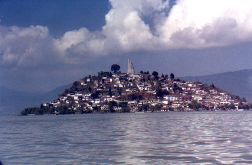 |
| |
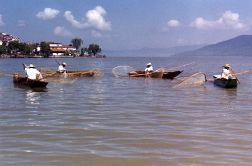 |
|
On returning to the campground Bev. and Bill Coons
celebrated their fortieth wedding anniversary which was toasted with
Cold Duck (a sparkling wine) followed by an impromptu tears-in-the-eyes
joke session.
|
Monday, 16 December 1996
Patzcuaro is still a one hundred per cent pure
Indian village, having white-washed adobe houses with overhanging wooden roofs
and many cobbled stone streets. In one of the Plazas is a statue of Don Vasco de
Quiroga, an attorney but later a bishop, who early in the sixteen century was
sent over from Spain to find out why there was so much unrest. He found that the
Indians were being persecuted so he decided to make far-reaching changes which
also gave them back their self-respect. He introduced skills such as copper,
weaving and woodworking etc. and persuaded villages to specialise in one area
which considerably improved their prosperity. Today villages still specialise in
the same skills as they have done for the last four hundred years. He made such
a positive mark on Mexico that he is still today reverently called Tata Vasco -
Uncle Vasco.
A church which has been converted into a library contains a
vast and incredible mural painted by Juan O' Gorman in 1942,
depicting the whole history of the Purepecha people from
prehistoric times, to the period of the Indians and to the time
after the conquest by the Spaniards.
Tuesday, 17 December 1996
It was time to move on to
Guadalajara which meant leaving before dawn at 7 am as it was a 200-mile
journey along slow and difficult roads. It turned out again to be an eventful
journey for some of the RVs! We were tailgunning the first group when a passing
motorist in sign language pointed out that the tow bar on one of the cars was
coming loose. The problem was temporally solved by Bill's wife driving the car
the remaining hundred or so miles.
Upon arrival at the campground, we learnt that bigger problems
had occurred with the other two groups. One rig broke down after
about thirty miles when the transmission overheated and seized
up, we hope that they will be able to rejoin us after repairs.
A large Caddilac car towing an Airstream trailer was badly
damaged when the car drifted off the steep camber at the side of the road,
hitting numerous large rocks, fortunately, nobody was hurt. The car which was
badly damaged but still driveable was being driven by J. D. who is from Texas
and looks like a classic cowboy, albeit about 80 years old.
During the journey to
Guadalajara,
we went through Zomora which is the largest
strawberry-growing area in Mexico. We stopped briefly at
El Salitre to gaze at and photograph a geyser, which unlike those in
Yellowstone park, continuously ejects water about one hundred feet into the air.
Wherever we go the locals continue to wave and to our surprise so do many
policemen.
Wednesday, 18 December 1996
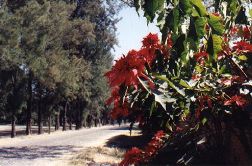 |
|
Today we settled into what will be our home for the
next month or so. The campground lies on the southeast outskirts of
Guadalajara and is the best site we have seen so far in Mexico. The
approach road is a mass of giant poinsettia and numerous other flowering
bushes, it certainly seems that this is a land of perpetual spring. We
appear to have reasonable electric, water and wastewater disposal
services as well as cable TV with four English-speaking channels.
|
| During the two weeks it has taken us to
get here there has not been any chance of washing dirty
clothes, so one of the early tasks was to arrange to get
the dirty laundry attended to. Laundromats do not appear
to exist so we are pleased that we can get the washing
done for 15P (£1.20) per load by a local lady in the
campground. |
Thursday, 19 December 1996
|
Because of the difficulty of parking in
Guadalajara, a hired coach took us into the centre for a guided tour
of the historic area. Guadalajara was founded in 1542 and today has a
population of about 2.8 million. The twin-towered seventeenth-century
Metropolitan Cathedral is a
predominant landmark that is easily recognised from the air and is used
as a logo on local taxis. Within the cathedral lies the body of a
twelve-year-old girl known as Saint Innocencie, she was shot along with
her mother by a French company of soldiers in the eightieth century.
When the girl’s body was dug up many years later it was perfectly
preserved whereas her mother’s body was as expected, no more than a pile
of bones.
We were due to visit the
Palacio Municipal (City
Hall) but outside a group of students were noisily protesting about
their 60P/week (£5) allowance, so the police blocked the entrance.
|
|
 |
The
Hotel Frances is the oldest hotel in continuous use in
Mexico, opening in 1610 and even today is a very impressive building having
three floors built around an open courtyard. The
Degollado Theatre & Opera House
is a majestic neo-classical theatre whose facade carries a frieze depicting
"Apollo and the Nine Muses" (1856-1866). It is a beautiful building with
gold-decorated boxes on four levels filling three sides of the auditorium. As on
previous occasions, Ed had organised a local expert, in this case, Senor Xavier,
to tell us more about the history. He turned out to be not only knowledgeable
and interesting but also demonstrated a real passion for the theatre.
As seems the pattern with these tours we adjourned for a
delicious lunch together in a Mexican Restaurant, we will say more about Mexican
food on another occasion. After which we spent about an hour viewing the 79
large murals painted by Orozco which depict in a very graphical but to us
depressing manner, both the positive and the negative aspects of the history of
Mexico. The murals are housed in what was originally planned as old people's
home but then as today, the Mexicans look after their own so it was never put
into use. As the coach was not due to leave until 3.30 pm we had enough time to
visit and spend some pesos in the local market. The market is a huge three-level
affair so we decided that we would return on our own another day and spend more
time bargain-hunting. Spent the evening putting up our Xmas decorations in the
RV, but it would appear that we will be more than outdone by the extensive
displays of some of our fellow travellers.
Friday, 20 December 1996
With three others George attended a meeting of the local ham
radio club which was held in an American retirement conclave near
Lake Chapala. One positive
outcome was that the Chairman decided to arrange on the 17th
of January, an additional examination so that George and two others
could sit for their ham radio licence. So it is back to studying!
Saturday, 21 December 1996
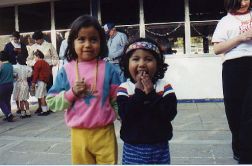 |
|
It seemed that everybody in the campground decided
to have the delicious eight pesos, all-you-can-eat. pancake breakfast in
the clubhouse. After which we accompanied Santa Claus and helped him
give out presents to the children in the village adjacent to the
campground. It was a lovely experience watching the smiling faces of the
young children who seemed delighted with simple gifts such as a pencil,
orange and sweets. The village is in a poor state of repair and not
everybody has running water. At the side of the road are car wrecks
dating back to the 40s which have been stripped and the parts sold. We
continue to see many examples of the genuine friendship and honesty of
the Mexican people.
|
The Shaders whose RV's transmission failed were over the moon about the way
the Mexicans had gone out of their way not only to carry out repairs as soon as
possible but also to ensure they were made comfortable during the two days it
took to carry out the repairs. In the afternoon we went with the Kotte's and the
Coon's shopping at what we believe is the biggest Walmart store anywhere having
54 checkouts!. After which it was back to play a few more games of Pegs &
Jokers.
Sunday, 22 December 1996
|
Today we went to a Mexican rodeo and wished perhaps
we had not. It got off to a very slow start at midday with riders
attempting to race and then stop their horse in a small marked area.
This was followed by running horses and bulls being lassoed. The horses
appeared to be very thin having cuts and sores and the bulls chased
until they were exhausted and were then lassoed and pulled to the
ground. One can debate the pros and cons of rodeos but the rodeo we saw
in Wyoming was performed with animals in first-class condition and men
who had a real chance of injury.
|
|
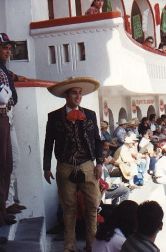 |
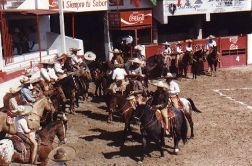 |
|
On the way back we all stopped for a hamburger. This was no
ordinary hamburger as they claim to make the largest hamburgers
in the world, being about one foot in diameter and filled with as
much salad as one can manage.
Monday, 23 December 1996
At 8 am six cars set off for the local fruit and vegetable
market where we found some very low prices including bananas at £0.07 per lb.,
large pineapples for £0.20 and good quality mushrooms at £0.68 per lb. There was
an amazing variety of pulses, peppers, spices, powders and dried items.
Initially, Ann walked us around the market explaining what was what and how to
cook some of the stranger items. Several very young children were trying to earn
pocket money by carrying purchases back to the car. When we returned to the
campground we found that as planned the RV had been washed and was in the
process of being waxed by a charming local lad who made a good job of the task.
Lunchtime saw us at a laboratory for Valerie to have a
blood test to monitor the correct dosage of cortisone. At the same time, the
doctor looked at the numerous bites she has developed over the previous few
days. It turned out to be an insect that lives in water and the bites, which are
in fact eggs carried in the bloodstream, should clear up with applications of
Herklin Lotion. Let us hope so.
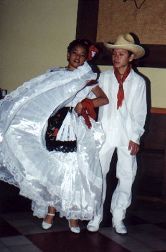 |
|
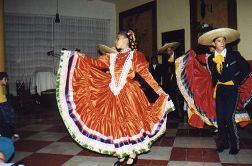 |
|
Later back at the campground we watched an
excellent presentation by about 50 children from the local orphanage run
by the Salvation Army. The show was a mixture of Christmas carols and
traditional Mexican songs and dances, and many of the performers were in
highly colourful costumes. To the delight of some of the audience, the
youngest children sat on their laps after they had done their turn.
|
| Dusk found us 1,000 feet above Guadalajara
watching the full moon rise and listening to an
astronomer explaining why sunsets are so colourful and
the reason for the various colour changes that the sky
goes through at sunset. We also watched the lights come
on throughout Guadalajara which
stretched out in front of us. It was then off to see what
must be one of the largest nativity displays anywhere,
this one is in a private house and covered the whole
garden. |
Christmas Eve - sunny 75
We have been a little surprised by how few Xmas cards have
been exchanged. However, in the evening the whole campground gathered in the
clubhouse for a Christmas eve meal. The format was that every RV brought enough
finger food for eleven people and presents costing no more than $5. The meal
turned out to be a splendid spread with a very wide variety of dishes. The
present giving had a novel twist in that each person was called up, in turn, to
select a gift from the pile and then open it in public, if they did not like the
item they could change it for any present that had been previously opened. The
result was hilarious as several popular gifts changed hands numerous times
before all the presents had been opened.
Christmas Day - sunny 76
|
After a late breakfast, we set off by coach to
Lake Chapala for our Christmas lunch at a lakeside five-star hotel
run by a Canadian couple. We had a five-course meal commencing with a
cheese Yule log, followed by a rich soup and then a mixed fruit and
salad dish. The main course was the largest serving of traditional
turkey and stuffing we have ever seen, which was accompanied by
cranberry sauce etc. but just to be a bit different we also had yams.
The cost of the three-hour meal including plum pudding, drinks and tip
was £16 per person.
|
|
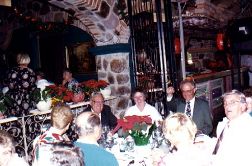 |
|
On the way to the hotel,
it became apparent that for most Mexican Christmas Day is a little
different from any other day. Their main day is Three Kings Day (6th
January) which is when they exchange presents.
|
Thursday, 26 December 1996
A day lazing around the campground chewing the cud. Happy hour at five
o'clock was held outside Sterling's RV, who cooked a delicious Cajun deep-fried
pastry which was then covered in icing sugar. The gathering then turned into a
delightful sing-song and joke-telling session. Valerie's bites now appear to be
slowly improving. It came as a shock to everybody to hear that Marshal, who is
one of our RV'ers was held up at gunpoint and ordered out of his car which was
then driven off by two youths, this all happened at 4 pm on the approach road to
our campground.
Friday, 27 December 1996
A day to ourselves and since we have been touring
extensively for most of 1996 we are enjoying the opportunity to remain in one
location for a period. George spent the day fitting daylight running lights to
the RV and Valerie attended line dancing lessons. Every day Jesse visits the
campground and sets up his stall. He is a local Mr Fix-it who seems to be able
to obtain anything, ranging from jewellery, clothes, medicines and items such as
Christmas decorations. He is a charming Mexican who knows how to persuade many
of the campground ladies to buy some trinkets or other almost every day.
Saturday, 28 December 1996
Other than sending some Email messages and a little food
shopping we again spent the day at the campground. We were due to
have a buffet breakfast at the American Legion but unknown to us,
the departure time had been moved forward 30 minutes, so we had
to cook our own. Three of the RV groups are from Louisiana and
one of their members is an excellent cook, so when they offered
to cook a Cajun gumbo for the whole campground we were all
delighted. A gumbo is similar to a mildly spiced casserole, on
this occasion containing chicken which was very enjoyable.
Sunday, 29 December 1996
Out of curiosity, we went with most of our fellow Aztec Trail
members to the American Society in Guadalajara
for a presentation on reincarnation! The talk was interesting and
almost comical at times. We found out that one of our travel
companions is certain that she has been reincarnated from a
previous life in ancient Egypt!
It seems that
Guadalajara
is another area where thousands of Americans have decided to make their
retirement homes and have established a highly developed support system and
active social life. It is understandable when one considers the almost ideal
weather, low cost of living and safe environment. We then went to a Lebanese
restaurant where they had an enormous buffet, so yet again we overate - we think
a new year’s resolution is called for. At 5 pm we had the usual happy hour where
next week’s programme was reviewed.
Monday, 30 December 1996
Having learnt the previous evening that Dr Michael Ritota
is highly respected both in Mexico and the US, we were almost looking forward to
our half-hour appointments with him. Unlike the custom back home, we were
invited together into his consultation room where he first reviewed Valerie's
medical history and then carried out a physical examination and an ECG. He
recommended that she should change her treatment for rheumatism to a new drug
and also prescribed treatment for blood pressure. To our surprise, he then
entered all the recommended drugs into his desktop computer, which within three
seconds was transmitted by satellite to Atlanta and confirmation was obtained
that the drugs would not have any interaction problems.
George then had his turn which fortunately went well other
than an ear infection, so it was then off to the pharmacy to obtain the drugs.
Unlike most other western countries drugs can be obtained in Mexico without a
prescription and fortunately most drugs cost only a fraction of that in the US.
New drugs are very often available several years before the UK or the US, but
obviously, this can also have a downside.
>>>
Home




